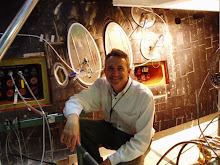 To the left is µMLAS Rev A ... the evolved MLAS in 1:20 scale. That particular size came about after an e-mail exchange with Gordon Agnello of Roachwerks, my µMRZ nose cose producer. A 10" OD part was about the largest he could comfortably turn on his lathe. The full-scale MLAS as we then envisioned it would be 216" in diameter at the base -- just large enough to encapsulate a full-scale Orion CM with a gap of a few inches around the fairing lip -- so 10" worked out to a 1:21.6 scale. Gordon agreed to push the edge a little and fabricate a 10.8" diameter part which made for a convenient 1:20 scale. As it turned out, I'm glad Gordon didn't have a bigger lathe .... µMLAS and its cousins didn't seem very "micro" when I was filling and sanding.
To the left is µMLAS Rev A ... the evolved MLAS in 1:20 scale. That particular size came about after an e-mail exchange with Gordon Agnello of Roachwerks, my µMRZ nose cose producer. A 10" OD part was about the largest he could comfortably turn on his lathe. The full-scale MLAS as we then envisioned it would be 216" in diameter at the base -- just large enough to encapsulate a full-scale Orion CM with a gap of a few inches around the fairing lip -- so 10" worked out to a 1:21.6 scale. Gordon agreed to push the edge a little and fabricate a 10.8" diameter part which made for a convenient 1:20 scale. As it turned out, I'm glad Gordon didn't have a bigger lathe .... µMLAS and its cousins didn't seem very "micro" when I was filling and sanding.There's nothing exciting about an empty shell, so Gordon agreed to make me a Crew Module to go with it. The CM fit snugly in the fairing with its forward shoulder resting against an internal bulkhead. Gordon did both parts in fiberglass and provided them sealed, primed, and ready-to-paint. He left the center of the CM open for receiving a piece of 2.5" PML tubing. I wanted a complete model in-hand for our first major design review, so opted to cluster four 24mm motors up the center of the CM instead of mounting them in the fairing. The CM would carry the fairing along with it in flight and be separated at ejection; the two pieces would be recovered on seperate chutes. I used 1" PVC for the dummy nozzles attached to the fairing. The stand shown in the photo was made from music wire and a couple of 10" embroidery hoops. µMRA made it to our design review just-in-time, smelling strongly of fresh paint.
The CM-in-fairing was fine for a show-and-tell model, but for flight there was the little issue of aerodynamic stability to consider. µMRZ required a lot of ballast and µMRA even more. The MLAS aero guys were kicking around options to address the stability issue for our flight test article, and a ballast spike, flared "skirt," and deployable grid fins similar to those flown on Soyuz were all under consideration. A custom TVC-equipped propulsion system could be designed for a crewed flight vehicle that would easily solve the stability problem, but for our concept demonstrator we didn't have the time or budget for such. The aero team ultimately settled on a separable ring with four fixed fins to be attached to the back of the fairing. The fins would be sized to provide stability at whatever margin we chose and would simulate the aero stability mechanism of an objective system whether that was TVC, ballast, grid fins, or some combination of those. Fixed fins would serve our purpose: we could do a concept demonstration with those, including a parachute-assisted turnaround maneuver and capsule/fairing separation, without incurring the cost of custom motors.
So again, the MLAS design evolved. And with its one day of design review glory behind it, µMRA became obsolete.
So again, the MLAS design evolved. And with its one day of design review glory behind it, µMRA became obsolete.

No comments:
Post a Comment